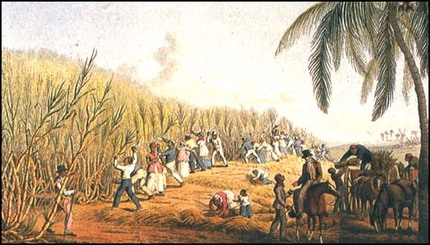Causes of the Forced Migration of Africans
4.2.3 By: Victor Hibbeln
Europe The forced migration of African people can trace its roots back to 1492, when Columbus discovered America. The discovery of the Americas led the major European powers such as the Spanish, English, and Portuguese to colonize the them. Along with the colonization came the need for a work force to run the industries, such as silver mining and the processing of sugar cane, that were set up in the colonies. Thus, if the Europeans had not been looking for a route to India in order to trade for its spices or had not continued their travels to the Americas in search of gold and silver, the forced migration of the Africans would have at least been delayed for a couple of years.
The search for riches in the Americas led to the European countries such as Spain and England establishing colonies in the South and North America respectfully. When the Spanish established their colonies in the West Indies, notably Jamaica and Cuba, they initially tried to use the native people as their work force. However, this was unsuccessful because the natives physically could not handle the work load that the Spanish demanded of them and not all of them were used to working in the tropical climate. Also, the native people were not immune to European diseases and many of them died from smallpox and other diseases brought to the Americas. Because of this, the work force that the Spanish could draw from was severely limited and those who were slaves for the Spanish often died from diseases anyway. Consequently, the Spanish had to search for another source of labor, thus leading to the forced migration of Africans. When the English settled in North America, they first practiced indentured servitude. This is where lower class English citizens could travel to America for free, but had to work in order to pay off their debt. While this practice was somewhat successful, it was very costly to the servants’ master because they had to feed, train, and pay them. In comparison, the slaves that were forced to the Americas from Africa did not need to be paid or trained, thus it saved the masters’ time and money and made African slaves a much more appealing source of labor. Also, the English did not actually try to enslave the Native Americans in North America because they saw them as trading partners rather than potential slaves. In addition, the English were able to colonize the West Indies, where they set up numerous sugar mills, but, like the Spanish, could not muster an effective work force out of the native population. Because of this, the English began bringing in African slaves to work on their Sugar Mills as well. The Africans, unlike the native peoples, were used to working in the tropical climates and were immune to many of the European diseases. This is because Africans, like the Europeans, worked and lived closely with their animals, thus allowing them to become immune to many of the same diseases. Also, Africa is located very close to Europe and often traded with European countries, thus they were able to be exposed to many of the diseases that the Europeans had. Another reason is because unlike the native people in the Americas, the Africans were used to doing hard labor. This is because there was a system of slavery in Africa prior to the slavery in the Americas. Finally, the Africans were not Christians. This is important because the Europeans saw it as wrong to enslave other Christians, thus they did not see it as an option to enslave their own people. |
|
Africa Another primary cause of the African slave trade was the fractured nature of the African groups. In Africa, it was common practice that conquered tribes would become enslaved by their conquerors. This was important because when the Europeans came to Africa, they could not conquer it due to the climate and their susceptibility to African diseases, specifically Malaria. This meant that the Europeans could not forcibly conquer the Africans or enslave them. However, because of the many fractured groups in Africa that already practiced slavery, the Europeans were able to take advantage of them. For example, the Trans-Saharan trade routes had existed in North Africa since the prehistoric times, reaching its height in the 8th century. The different African groups often traded slaves along this trade route as well, which proves that slavery was not new in Africa. Olaudah Equiano, a former slave from Nigeria who was enslaved by the British in the Barbados and Virginia, describes how his father owned slaves, which provides evidence that slavery already existed in Africa. The Europeans were able to trade weapons and other goods to the Africans in return for slaves that could be shipped over to their colonies in the Americas. Equiano describes how the children used to keep watch for rival African groups who would want to kidnap them and sell them as slaves to the Europeans. In fact, Equiano himself was kidnapped by a rival African group and was sold to the Europeans as a slave. This trade of European weapons for African slaves created a kind of cyclical effect, where in order to protect the village from other groups, the Africans would have to engage in the slave trade to get better weapons to defend themselves. This effect of each group trying to gain the upper hand militarily led to an increase in slave trade. Thus, if the groups in Africa had not been so fractured, the Europeans would not have so easily taken advantage of them and would have perhaps had to go looking for slaves from elsewhere in the world.
|




